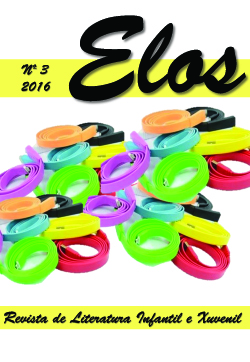Characterization of the fantasy genre of Children and Young Adults Literature
Main Article Content
Abstract
: Nowadays, it’s still difficult to specify the reach of the term fantasy literature. On the other hand, this same name refers to very different literary works in the case of literature for adults and as for literature for children and young people. The presence of the fantastic in this last group has a different origin, and it means for its receivers the possibility of contacting with readings which reflect their way of understanding the world. Through this work, the need and validity of the fantastic in the Children and Young Adults Literature will be argued, at the same time that the forms of the genre it refers will be determined.
Keywords:
Article Details
References
Blázquez Ortigosa, A. (2009). “Conceptos básicos de la literatura infantil”. Innovación y experiencias educativas, 17. Consultado o 10 de decembro de 2015, http://www.csi-csif.es/andalucia/modules/mod_ense/revista/pdf/Numero_17/ANTONIO_BLAZQUEZ_ORTIGOSA_1.pdf
Colomer, T. (2010). Introducción a la literatura infantil y juvenil actual. Madrid: Síntesis.
Cortés Palomino, M. (2011). “La desaparición de la infancia. Dos perspectivas teóricas”. Educación y Pedagogía, 23 (60), 67-76.
Davis, R. (2000). “Mundos paralelos: un acercamiento a la fantasía en la literatura infantil”. RILCE, 16 (3), 491-500.
García de Lima, L. (2008). “Pós-modernidade e a negação da infancia”. Ponte Grossa, 8 (2), 35-47.
Held, J. (1985). Los niños y la literatura fantástica, función y poder de lo imaginario. Barcelona: Paidós.
Láquesis, A. (2013, xuño). “Importancia de la fantasía en la literatura infantil”. Fantasía Austral. Consultado o 20 de novembro de 2015, http://fantasiaustral.cl/web/importancia-de-la-fantasia-en-la-literatura-infantil-i/
Lozano Palacios, M. I. (2012). Aproximación a la literatura dramática juvenil actual: definición, determinación del corpus y análisis. Alcalá de Henares: Universidad de Alcalá de Henares.
Montoya, V. (2001). “El poder de la fantasía y la literatura infantil”. Sincronía, 4. Consultado o 12 de decembro de 2015, http://sincronia.cucsh.udg.mx/litinfant.htm
Piaget, J. (2001). Seis estudios de psicología. Barcelona: Editorial Labor. [1ª edición, Six Études de Psychologie, 1964].
Postman, N. (1994). The Disappearance of Childhood. New York: Vintage books.
Rubio Pérez, S. (1999). “Reflexiones sobre la literatura infantil”. Educere Artículos, 6, 28-31.
Saint-Exupéry, A. de. (2006). O Principiño. Trad. Carlos Casares. Vigo: Galaxia. [1ª edición Le Petit Prince, 1943].
Silveyra, C. (2010). “El futuro de la LIJ fuera de la escuela”. En Actas y memoria del I Congreso Iberoamericano de Lengua y Literatura Infantil y Juvenil (CILELIJ). (pp. 395-400). Santiago de Chile: Fundación SM, Consultado o 12 de decembro de 2015, http://www.fundacion-sm.com/ArchivosColegios/fundacionSM/Archivos/LIJ/132195_ACTAS_primera%20parte.pdf
Suárez, B. T. (2007). “Realidad y fantasía en la literatura infantil y juvenil”. Educación y Biblioteca, 161, 38-40.
Téllez Robles, C. (2003). Fomento a la lectura en niños de ocho a diez años. México: Universidad Pedagógica Nacional.
Todorov, T. (2001). “Lo extraño y lo maravilloso”. En Roas, D. (Ed.). Teorías de lo fantástico (pp. 65-82). Madrid: Arco/Libros. [1ª ed., Introduction à la littérature fantastique, 1970].
Most read articles by the same author(s)
- Rocío García Pedreira, Anuario de Investigación en Literatura Infantil y Juvenil, 13 (2015) , Elos: Revista de Literatura Infantil e Xuvenil: No 3 (2016)






